
Do you ever wonder if eBooks are still relevant? Visme finds that eBooks are effective lead magnets. Plus, eBooks are an excellent tool to establish your authority. That’s why you shouldn’t leave out eBooks in your content marketing strategy. And if you want to give eBooks a try, here are design tips to make killer eBook graphics.
1. Stick to Your Branding Colors
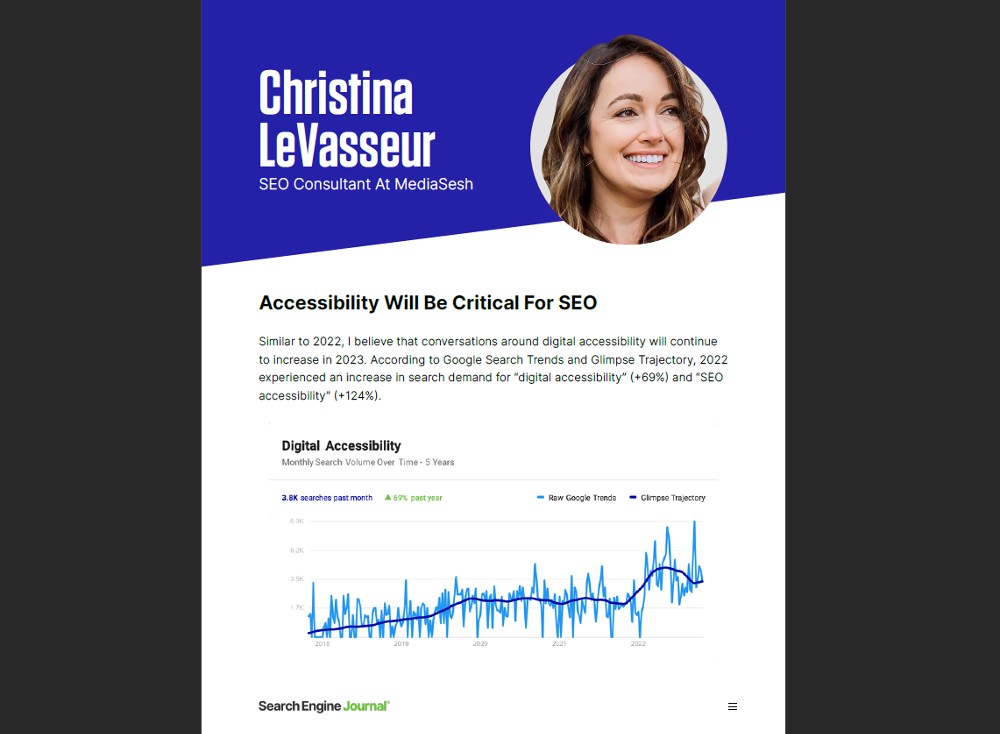
You can take inspiration from the latest graphic design trends on how to design your eBook. But it’s ideal to stick your brand’s palette at all costs, from the cover to the pages. After all, you want to maintain branding consistency across different channels or mediums.
Take a look at this example from the Search Engine Journal. The renowned SEO news company uses green. However, they also use a blue motif on their website and social media pages. Those two colors are prominent in their eBooks. And if you observe this best practice, you will have stronger brand recognition.
2. Add Charts and Graphs
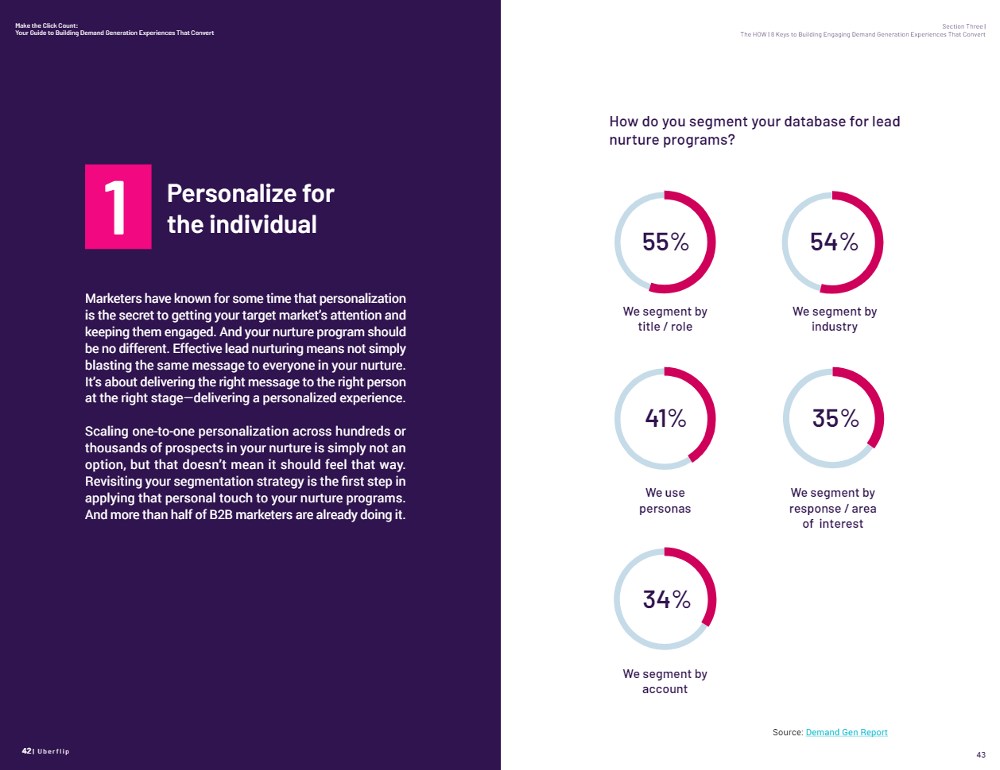
It’s important to present data visually. You need to add charts or graphs for case studies, most especially. It’s an effective way to show growth or progress. Plus, it’s easier to interpret data with charts or graphs. When including charts or graphs, avoid getting stock photos. Ensure you’re creating a custom chart or graph for data. You can do this with a spreadsheet tool or graphic design software.
Check out how Uberflip uses charts. You can use a similar chart design like theirs if you’re presenting various data. Or if you want to emphasize population size. Plus, use the same color palette or choose hues from your primary color scheme. This is when you can make an exception to branding colors. It’s to help you distinguish elements apart.
3. Make it Visual with Photos and Illustrations

Avoid text-heavy eBooks by adding high-quality photos or custom illustrations since you don’t want to drown your reader in seas of text. But don’t add just any images to your eBook.
If it’s possible, use your company’s official photos. This introduces the reader to your company. Plus, it gives the eBook a personal touch. However, you can opt for stock images if you don’t have official photos ready yet. To avoid any legal trouble, look for open-source or no-attribution stock images.
Like photos, you have two options for obtaining illustrations for your eBook. The first is using stock illustrations. It’s easy to find stock illustrations online. But make sure to find and download ones without needing attributions.
The second option is getting custom illustrations. Illustration licensing can be tricky. You might have permission to use illustrations on specific platforms or mediums. That’s why many businesses opt for custom-made illustrations. This saves them the trouble of buying licenses. Plus, they’re steering clear of any legal trouble that would befall them.
Wrike’s eBook is one of the best examples of using illustrations in eBooks. Their illustrations are added to each section’s introduction. In addition, they ensured that the illustrations also corresponded to the sections or chapters.
4. Use Icons
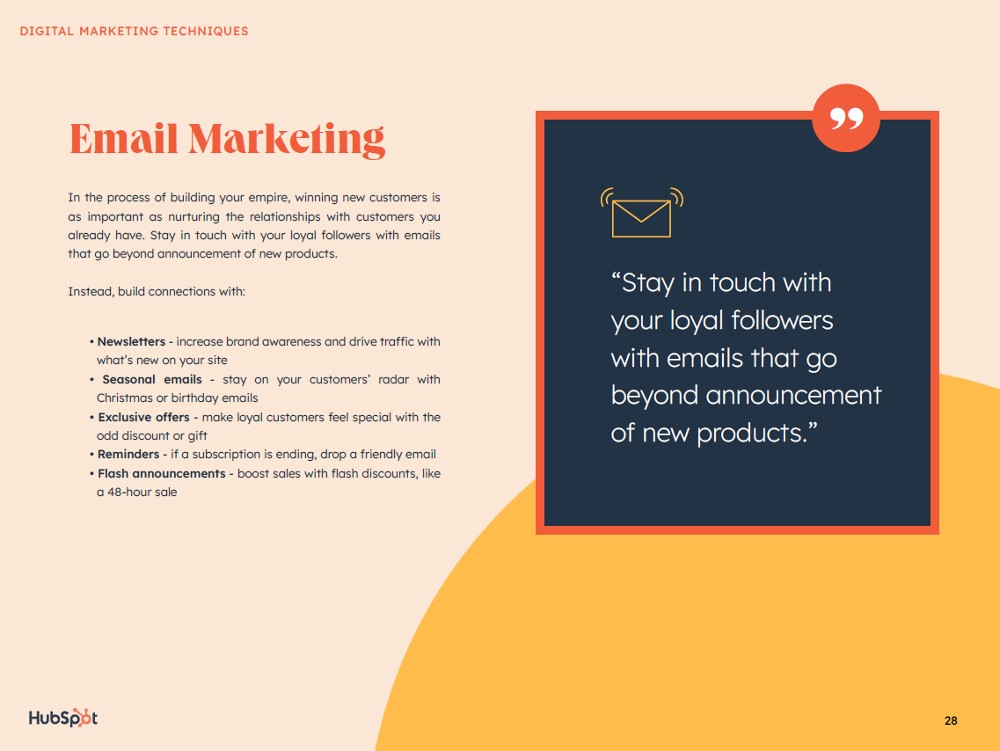
Illustrations aren’t the only visual that could serve as a representation of text. Icons are another example of making your eBook engaging to the reader. You can go with simple icons like arrows or shapes. Or, you can use icons that will replace text, like this example from Hubspot.
The icons they use on their ebook are:
- Envelope (mail)
- Piggy bank (cash or money)
- Magnet (leads)
- Person (user experience)
- Measuring tape (metrics)
5. Keep it Consistent with Fonts
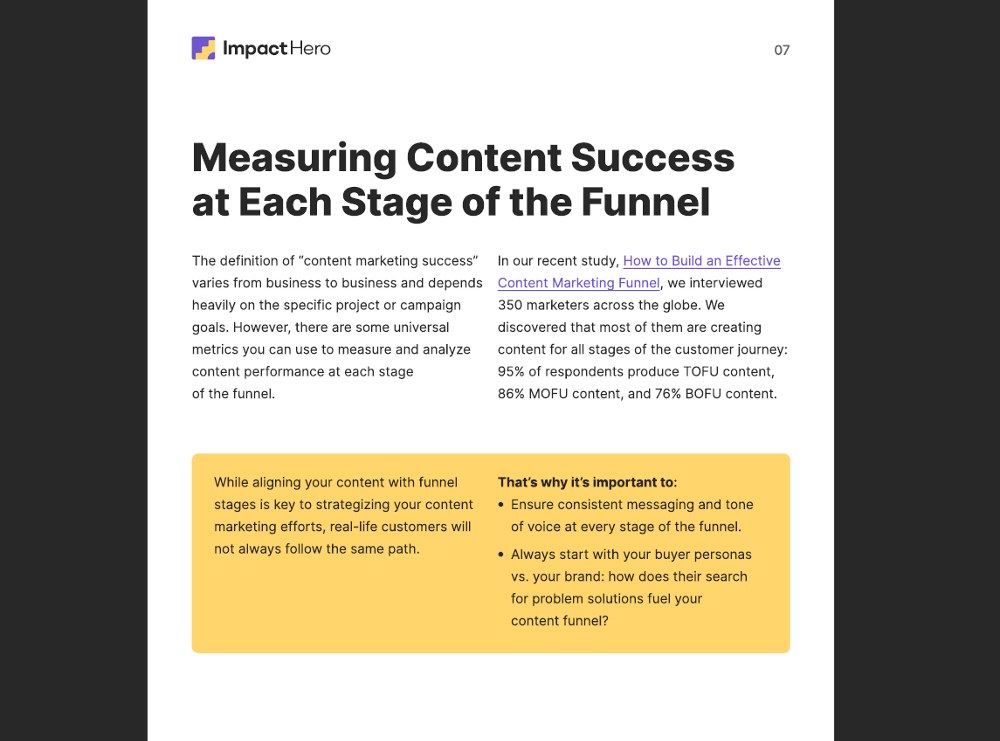
Similar to your brand colors, ensure that you’re using your custom fonts too. But, if your custom typography isn’t a good fit for your eBook, you can explore different fonts instead. Make sure that it’s readable. Plus, it’s better if it’s part of a font family so you can keep the same font type on every page.
Here’s Semrush’s eBook for inspiration. They use only one font type from the cover to the last page. By doing this, you help the viewer read seamlessly from one page to another. Plus, it’s easier on the eyes.
6. Make Use of Whitespace
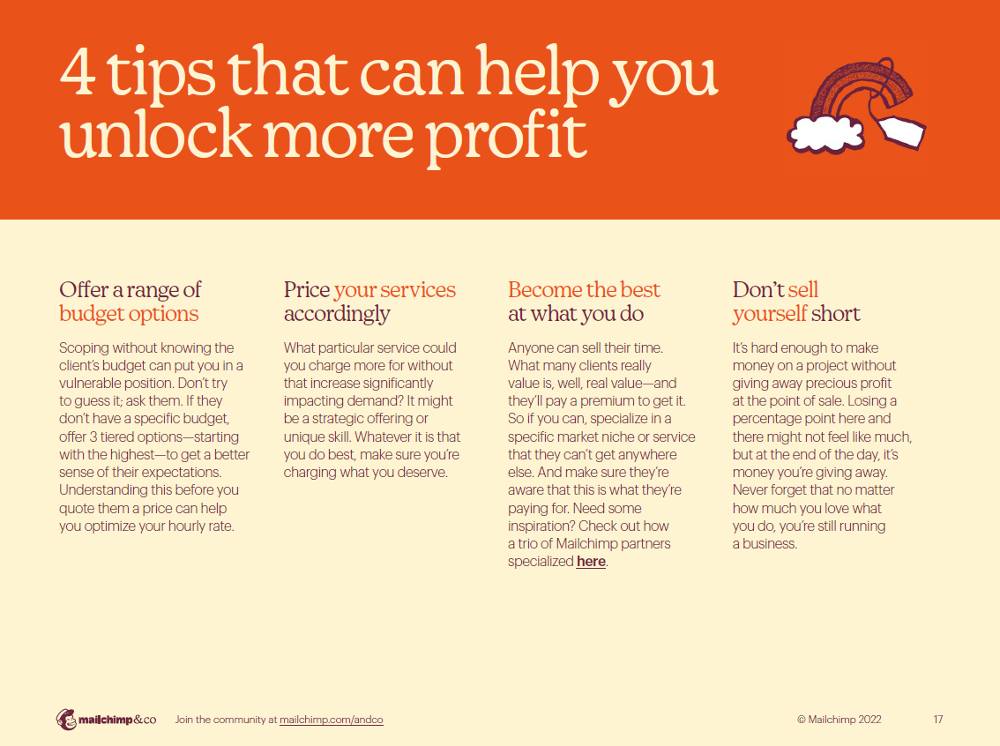
Once you’ve completed your data, text, and eBook graphics, it’s time to organize it. When you design an eBook, you have to consider whitespace. Simply put, you want to arrange your eBook without putting too much info on one page. Graphic designers add images or shapes to create contrast, balance, and visual hierarchy. Plus, it contributes to better readability.
Here’s an example from MailChimp. They use different strategies to use whitespace, such as color blocking, adding columns, incorporating visual hierarchy, and putting images or illustrations. With these in mind, your eBook will be easier to read.
7. Create a Captivating Cover
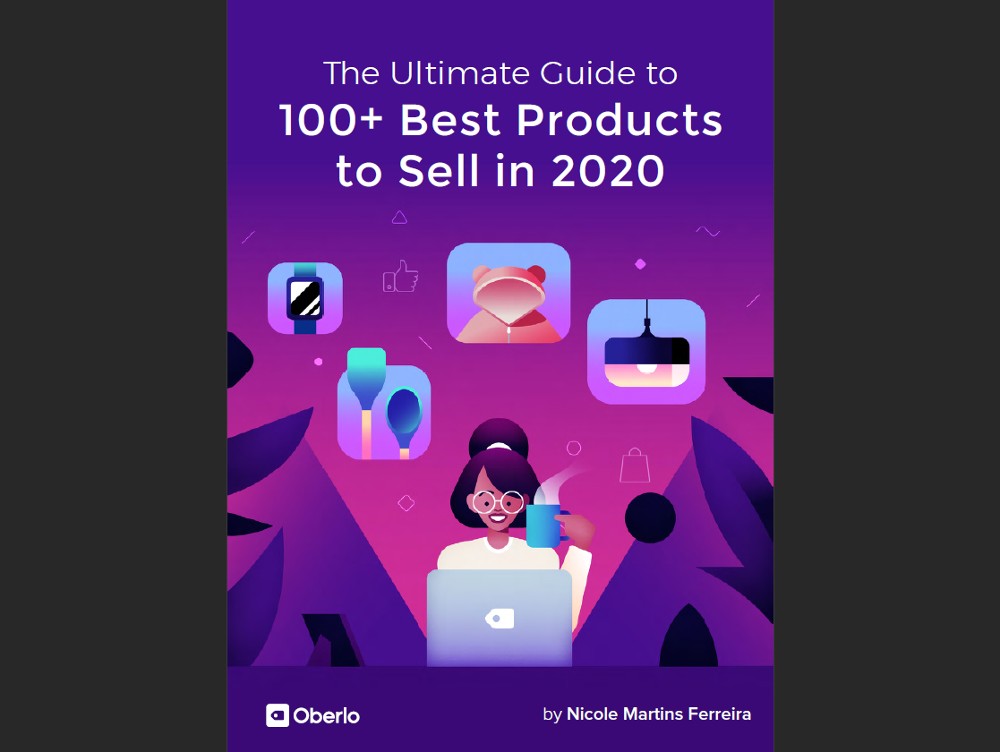
You’ve finally completed designing your eBook pages. All you have left is to create an eBook cover that will get your reader’s attention. Sure, the title and premise of your eBook can convince your target audience to read it. However, if you consider a plain white background with the title and author as your cover, expect readers to find a better eBook.
A captivating cover includes:
- Colorful graphics
- Bold text
- Pictures or illustrations
- Branding assets
Here’s an oldie but a goodie from Oberlo. You can grab a reader’s attention with bright colors and captivating illustrations. Plus, you’ll notice the text’s subtle boldness to emphasize the eBook’s gist.
How Do I Make eBook Graphics?
The easiest way to make eBook graphics is through graphic design software. Most graphic design software applications offer eBook templates and other visual elements. Although the tool is available, you need to draft the eBook content before using any graphic design software. This keeps you on track, and your eBook will be organized.
Where to Get Your eBook Graphics?
1. Open-Source Image Sites & Illustrations
Your eBook may need to show actual people emphasizing a point or adding a visual among the blocks of text. If you don’t have official company photography or can’t invest in custom photography yet, open-source image sites can help you find images for any purpose! Open-source image sites don’t need attribution and can be used for commercial purposes.
Unsplash is a popular example. You can find millions of images. However, you can maximize Unsplash by subscribing. This way, you get other images that fit your requirements.
One competitor is Pixabay. Pixabay doesn’t only offer high-quality images, but there are illustrations and vectors you could add to the eBook.
If photos aren’t the right images for your eBook, then you should consider illustrations! Illustrations can be a more entertaining choice. Plus, you don’t have to worry about showing random people on your eBook. Besides entertainment, illustrations can also make your eBook compelling. But where do you get open-source illustrations?
Undraw is a popular choice for open-source illustrations. You can get flat character and object designs. One advantage of Undraw compared to its competitors is that you can change the colors to fit your branding. Plus, they allow commercial use.
Drawkit is another site where you can download open-source illustrations. Unlike Undraw, Drawkit has 3D illustrations if you need compelling images to add to your educational eBook.
However, a drawback of using open-source illustrations is you might have similar illustrations with other companies. This could affect your branding.
2. Paid Images and Illustrations
If you have the money to spend on your eBook graphics, you can search for various photo and illustration marketplaces to buy these visuals. Shutterstock is one of the most popular sites for buying images and illustrations. However, buying from Shutterstock means you have to note the licenses, as some do not allow commercial use.
Meanwhile, if you need illustrations only, Creative Market is the go-to for most graphic designers. You can buy in bulk when you subscribe monthly or buy an illustration pack as is. However, like open-source images and illustrations, these images aren’t custom to your business.
3. AI
AI is another way to get eBook graphics. This is when you can’t find the EXACT image you’re looking for, and you don’t want to hire a graphic designer just yet. Consider AI as a last resort before approaching a graphic designer. Their designers still need more improvement. Plus, it’s hard to edit some of them since the AI produces a “final” output.
4. Graphic Design Software
Aside from creating your eBook with graphic design software, you can also create visual elements and graphics using a graphic design application. You can create custom objects with the draw feature. Or you can also use elements to make a custom shape or design! Plus, you can also edit an image if you need it.
Canva is one of the top graphic design software apps for beginners and experts. You don’t need experience using any graphic design work with this software since they provide templates. However, as promising as Canva sounds, it can be tricky for non-designers to create custom images. Plus, not all elements are available on the Free plan, prompting you to create a design by yourself, which might be difficult to replicate.
However, if you have data-driven eBooks or need to show numbers in graphs or charts, you’ll also need a graph maker. Visme is one of the best tools to create graphs. The graphic design software specializes in creating infographics and graphs or charts to make them visually appealing to audiences. However, the graphic design app has limited functionality on the Free plan. Plus, you need to upgrade to download your graph into an image file.
5. Graphic Designers or Illustrators
Your eBook is also a part of your brand. And if you want your brand to look consistent on every page, you need custom graphic design work from actual designers. This makes the brand experience seamless across various platforms. Plus, your audience will recognize your brand even from an eBook. Meanwhile, you can also approach illustrators for custom illustration work for your eBook. This will make your eBook look compelling and unique.
You can find graphic designers or illustrators on freelance sites like Upwork and Fiverr for one-time projects like eBook designs. But they can also design your whole eBook. However, freelancers are ideal designers when you want to work with them once. Plus, it can be more expensive, considering some freelance designers work by the hour.
However, if you’re looking for an actual graphic designer to partner with but without the commitment of an in-house one, an unlimited graphic design service, like Penji, would suit you better.
How Can Penji Help with Your eBook Graphics and Design
Designing an eBook is a laborious task, especially if you’re doing it alone. But designing one shouldn’t be a solo project. And you’ll need help from experienced and skilled graphic designers.
Whether you need an eBook cover design, pages, or both, Penji is ready to take on your design requests. Before submitting your first design request, make sure that the written content is ready. This way, Penji designers can provide drafts quicker, and your eBook will be published ASAP. And if you want to give Penji a try with your new eBook, subscribe here!
About the author

Katrina Pascual
Katrina is a content writer specializing in graphic design, marketing, social media, and technology. In her spare time, she writes monthly personal blogs to practice her craft.
Table of Contents
- 1. Stick to Your Branding Colors
- 2. Add Charts and Graphs
- 3. Make it Visual with Photos and Illustrations
- 4. Use Icons
- 5. Keep it Consistent with Fonts
- 6. Make Use of Whitespace
- 7. Create a Captivating Cover
- How Do I Make eBook Graphics?
- Where to Get Your eBook Graphics?
- 1. Open-Source Image Sites & Illustrations
- 2. Paid Images and Illustrations
- 3. AI
- 4. Graphic Design Software
- 5. Graphic Designers or Illustrators
- How Can Penji Help with Your eBook Graphics and Design













